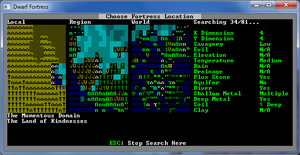- v50 information can now be added to pages in the main namespace. v0.47 information can still be found in the DF2014 namespace. See here for more details on the new versioning policy.
- Use this page to report any issues related to the migration.
v0.34:Quickstart guide/Starting site
- Also see: Embark
Finding a Good Site
What sort of stone you have on your map is important, but you only know if you have soil, clay, a metal (ore), more than one metal, an aquifer, or flux stone. This makes things a challenge because it's harder to figure out what you're going to get for metals.
Aquifers
You will especially want to avoid sites with Aquifers, as these can be incredibly difficult to dig through, leaving you without stone of any sort until you manage it.
Trees
Also, you will want to avoid sites that have no trees. Dwarves like to sleep in beds, and beds are only made from wood. Also you need to be able to make charcoal, which requires wood. You could dig down to the first cavern level and chop down giant mushrooms for wood, but even the uppermost cavern level often contains far more Fun than a newbie can handle.
Water
Having a brook or river on your site will make things much easier. It isn't a necessity, as there are other sources of water on most maps, but only oceans, lakes, rivers, streams, brooks, aquifers and some cavern layers contain unlimited quantities of the stuff; and of these, rivers and brooks are by far the easiest to deal with. Speaking of water, take a look at the Climate. In temperate or colder climates, above ground water will freeze during the colder months. This can be anything from a minor inconvenience to a major pain, depending on circumstances. Just be aware that it is one more thing you will have to deal with, and choose your climate accordingly.
Hostile Civilizations
While searching your map for a good site, hit the Tab key to change the display. You will notice that there are several informative screens besides the default screen showing the biomes and layer types. One screen shows the relative distance to different races' civilizations. If Goblins are too close by, you will suffer ambushes by your second spring. As a newbie, these goblins will very likely destroy you. If you like seeing dead dwarves and blood all over the map, go right ahead and pick a site next to a dark fortress.
You can set up your fortress to keep the goblins out, or kill them with Traps, but do not expect your militia to fight off these first waves. They will die. And remember, keeping goblins out means keeping traders out (or worse, stuck inside, wanting to get out.) Goblins will attack trade caravans, and you will be blamed if the caravans die. So, as a newbie, you may want to opt for a site far from goblins. If you choose an island site, you will notice that no other races are listed. Only dwarves will come to trade with you, but you won't be attacked by goblins.
Geography
It may also be helpful to choose a location with a solid cliff face and a decent mountain to dig into above ground, so that your fortress can have a more straightforward layout. It's also possible to ignore this and have a fortress that's entered from above, if you'd like, but some may find it easier to have all of the main parts of a fortress visible on one screen, to help facilitate an early understanding of how the fortress works.
Evil Biomes
Finally, you really, really do not want the surroundings of your first site to be "sinister", "haunted", or "terrifying". These areas are infested with aggressive, hostile creatures such as Undead versions of normal wildlife. Even experienced players may have trouble dealing with them, so it's best to avoid them for now.
